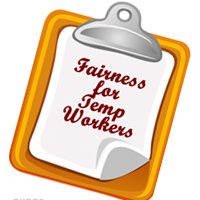Companies Increasingly Use Temporary Workers to Avoid Safety Regulations
 (graphic: NUPGE)
(graphic: NUPGE)
Just as employers use temporary workers instead of permanent ones to save money and drive down wages generally, a new report shows that avoidance of worker safety rules is another dubious “benefit” bosses seek when hiring temps, also called contingent workers. Released last week, the report suggests several reforms, including urging the government to target companies that often use contingent workers and to issue new rules to ensure they get proper safety training and protective equipment.
The report from the nonprofit Center for Progressive Reform (CPR) details the increasing use of contingent workers to perform dangerous, undesirable jobs in industries like farming, construction, warehousing and hotel services. Noting that the number of contingent workers has doubled in twenty years to more than 2.5 million, the report underscores Bureau of Labor Statistics data that they suffer higher rates of injury and death than other employees.
The economic and political vulnerability of contingent workers, who are often poor and sometimes undocumented, makes them easy to exploit not only with low wages and long hours, but also with unsafe working conditions. According to the study, because contingent employees rarely have health insurance or even workers’ compensation coverage, employers are able to shift the financial burden of workplace injuries onto the public, and often skimp on safety training of temps.
The recent case of Carlos Centeno is illustrative. In November 2011, Centeno was working for a temp agency and was assigned to a Raani Corp. plant near Chicago. The 500-gallon chemical tank he was cleaning doused him with a 185-degree mixture of water and citric acid, burning him over 80% of his body. When the company refused to call 911, a co-worker drove Centeno to get help, although more than 98 minutes passed before Centeno arrived at a hospital emergency room, and he died a painful death three weeks later. The only safety equipment given to Centeno that day was a pair of latex gloves and rubber boots.
Even after Centeno’s injury, Raani apparently made no changes. The day after Centeno died, the Occupational Health and Safety Administration (OSHA) inspected the Raani plant and found 14 safety violations, 13 of them serious or willful, and proposed a $473,000 fine and possible criminal prosecution. It was the first OSHA visit to Raani in 18 years; at the last one in 1993, the agency cited the company for six violations—including failing to protect workers from unexpected startup of machines—and proposed a $9,500 fine. Raani settled the case for $6,500 in 1994.
As Carlos Centeno’s story demonstrates, OSHA inspections are so rare and enforcement penalties are so light that workplace safety rules may be violated with impunity. In light of the fact that Congress has made OSHA into a toothless tiger by cutting its enforcement budget to the marrow, the CPR report proposes creating a private right of action under OSHA. This would allow any person to bring suit in federal court against any other person who violates provisions of the OSHA law or regulations.
Although a private right of action would certainly solve the problems with OSHA enforcement, industry opposition to this idea, which has been proposed before, is likely to be fierce. According to federal statistics, about 4,500 American workers die on the job and 50,000 perish from occupational diseases each year, while millions more are hurt and sickened at workplaces.
-Matt Bewig
To Learn More:
Report Suggests OSHA Safeguard Contingent Workers (by Chris Hamby, Center for Public Integrity)
At the Company’s Mercy: Protecting Contingent Workers from Unsafe Working Conditions (by Martha McCluskey, Thomas McGarity, Sidney Shapiro and Matthew Shudtz, Center for Progressive Reform)
“They were not Thinking of him as a Human Being” (by Jim Morris, Center for Public Integrity)
OSHA Averages One Workplace Safety Regulation a Year (by Noel Brinkerhoff, AllGov)
- Top Stories
- Unusual News
- Where is the Money Going?
- Controversies
- U.S. and the World
- Appointments and Resignations
- Latest News
- Trump to Stop Deportations If…
- Trump Denounces World Series
- What If China Invaded the United States?
- Donald Trump Has a Mental Health Problem and It Has a Name
- Trump Goes on Renaming Frenzy






Comments